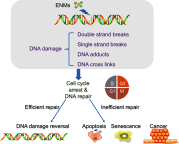The neurotoxicity induced by engineered nanomaterials
- PMID: 31239675
- PMCID: PMC6559249
- DOI: 10.2147/IJN.S203352
The neurotoxicity induced by engineered nanomaterials
Abstract
Engineered nanomaterials (ENMs) have been widely used in various fields due to their novel physicochemical properties. However, the use of ENMs has led to an increased exposure in humans, and the safety of ENMs has attracted much attention. It is universally acknowledged that ENMs could enter the human body via different routes, eg, inhalation, skin contact, and intravenous injection. Studies have proven that ENMs can cross or bypass the blood-brain barrier and then access the central nervous system and cause neurotoxicity. Until now, diverse in vivo and in vitro models have been developed to evaluate the neurotoxicity of ENMs, and oxidative stress, inflammation, DNA damage, and cell death have been identified as being involved. However, due to various physicochemical properties of ENMs and diverse study models in existing studies, it remains challenging to establish the structure-activity relationship of nanomaterials in neurotoxicity. In this paper, we aimed to review current studies on ENM-induced neurotoxicity, with an emphasis on the molecular and cellular mechanisms involved. We hope to provide a rational material design strategy for ENMs when they are applied in biomedical or other engineering applications.
Keywords: DNA damage; cell death; engineered nanomaterials; inflammation; neurotoxicity; oxidative stress.
Conflict of interest statement
The authors report no conflicts of interest in this work.
Figures





References
-
- Morris JE. Nanoparticle properties In: Morris JE, editor. Nanopackaging: Nanotechnologies and Electronics Packaging. Boston, MA: Springer US; 2008:93–107.
Publication types
MeSH terms
Substances
LinkOut - more resources
Full Text Sources

